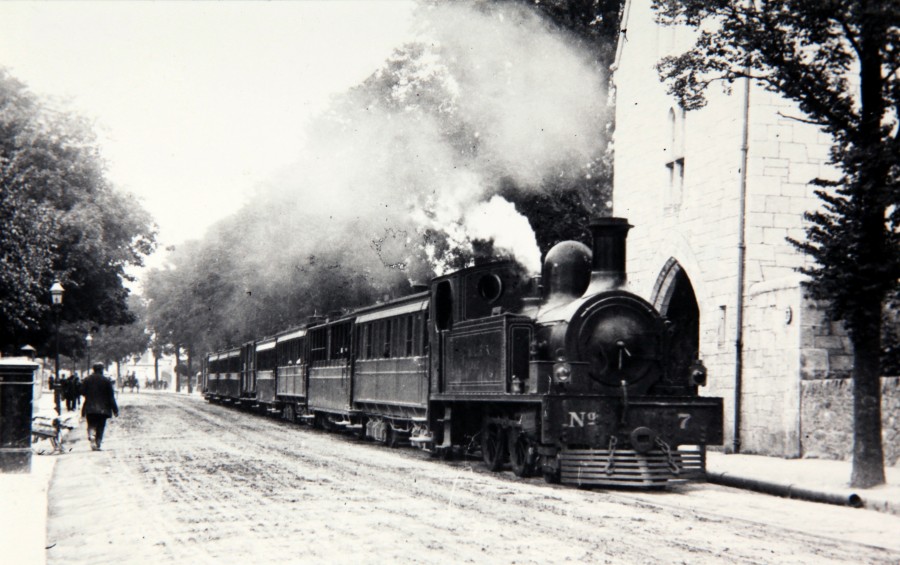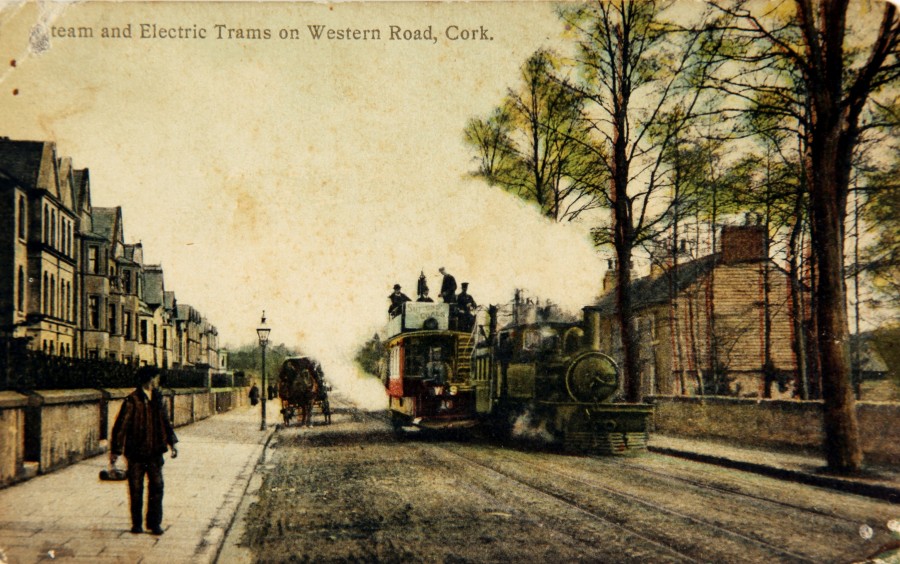
Kieran’s Our City, Our Town Article,
Cork Independent, 16 February 2017
The Wheels of 1917: Agriculture and the Cork-Muskerry Tram
One hundred years this week, on 20 February 1917, the Cork Muskerry Light Railway Company published their report for their annual general meeting in the Cork Examiner. The meeting was held at their offices on Western Road under the chairmanship of Mr George Colthurst (of Blarney Castle estate). The report gives insights into agriculture and the connections from the city into mid County Cork. The line was primarily built in the 1880s for tourists to link Cork to the tourist town of Blarney and its historic castle. Supporters of the railway line also aimed to provide improved transport for locals with livestock and farm produce between the farming area north-west of Cork and the city and for coal and minerals in the reverse direction.
Beginning on Bishop’s Marsh (now the River Lee Hotel), the Cork terminus was a single-storey building covered by a corrugated iron roof with a long platform. The iron engine and carriage shed spanned three tracks. the first four miles of the line going west were very like that of a tramway. From the terminus, the line crossed the south channel of the River Lee via a small bridge leading to Western Road. The iron supports for the bridge can still be seen. The initial stops were at Victoria Cross, Carrigrohane and then northwards to Leemount, Healy’s Bridge and Coachford Junction. there There were two branch lines, one to Coachford and the other from St Ann’s Hydro, near Blarney, which followed the Shournagh valley to Donoughmore.
In 1917 the physical railway line was deemed in a good condition but due to the war it was impossible to get timber sleepers. Two years previously, the railway company had placed an order for an engine but owing to war requirements they were unable to obtain the delivery of it. This, according to Mr Colthurst, placed them in a difficulty with regard to the repairing of their rolling stock. The company had been compelled to restrict somewhat their service of trains and were forced to take off the line two of their trains.
Financially the company was holding its own. The gross receipts for the company for the year end from all sources amounted to £12,072, as against £11,467 the previous year, which showed an increase of £605, compared with the corresponding period of 1915. Colthurst’s report highlighted that there were great increases in the numbers of boxes of eggs, fowl and butter carried over the line. The chairman noted that “it showed that the people of the country were returning to their old industrial pursuits and producing such commodities in abundance”.
Last year the Central Statistics Office published an account of agriculture based on contemporary statistics one hundred years. It denoted that farming was a significant industry for 1915-17 – there were 359,700 farms over one acre in Ireland whilst in 2010 the total number of farms had declined to 139,860 farms, a reduction of over 60%. In 1917 egg production made an important contribution to the rural economy, representing 11% of total agricultural exports from Ireland. Eggs were a consistent source of income and could be exchanged with local shopkeepers for crucial items such as tea and sugar which could not be produced on farms. The care of poultry and the income from eggs was normally a role taken on by the farmer’s spouse. It may have been her only source of independent income. The Department of Agriculture and Technical Instruction introduced initiatives for the improvement of egg production, including the establishment of egg production co-ops. Schemes to improve the breed of hen used and improvements in the packaging of eggs for exports were also introduced.
Colthurst at the Cork Muskerry Light Railway meeting highlighted increases in cattle and sheep carried over the Cork Muskerry line – cattle, 696, and sheep, 805 – but in pigs there had been a reduction of 66. The statistics from one hundred years ago reveal that most farms and small holdings kept a cow for milk for the house and liquid milk was not transported over long distances. In 1916, Dairy Shorthorn cattle were the predominant breed of cow used for milk production. Kerry cattle were utilised for milk production in Munster, especially in mountainous areas of Kerry and the Berehaven district of county Cork where larger breeds could not be kept. Kerry cattle were also kept on smaller holdings in Limerick, Cork & Tipperary. In 1916 beef production was primarily to produce live cattle for export. The main beef breeds in 1916 were Beef Shorthorn, Aberdeen Angus, Ayreshire, Hereford and the native Irish Dexter breed.
Colthurst in his report attributed the fault of the decrease in pig transport to the bacon curers who only paid low prices “for pork that would not enable the producer to produce pork”. From statistics, he highlighted that the number of pigs slaughtered in Ireland during 1916-17 was a little more than half of the number slaughtered three years previously. However the export of pigs was twice as much as it was three years previously. Many pig buyers took the pigs to England, where they were given a higher price for them than in Ireland. In general, almost 100% of Ireland’s exports in 1917 were to Britain, with Ireland mainly exporting primary products (i.e. products that required little or no processing such as live cattle, raw wool, eggs, etc). Today, the UK takes 41% of Ireland’s agri-export.
My book Inheritance, Heritage and Memory in the Lee Valley, Co. Cork (2010) is still available from www.historypress.ie (limited copies). It was based on a series of Our City Our Town columns on the histories and memories of Inniscarra and Dripsey.
Captions:
882a. Cork Muskerry Tram locomotive on Western Road, Cork City, c.1910 (source: Cork City Through Time by Kieran McCarthy & Daniel Breen)
882b. Cork Muskerry Tram locomotive on Western Road, Cork City, c.1910 (source: Cork City Through Time by Kieran McCarthy & Daniel Breen)

Press Release
Independent Cllr Kieran McCarthy has called for Cork City to rebrand itself as Ireland’s Southern Capital and lose such words as Ireland’s Second City- noting such terms as outdated and downgrading the city’s ambition. In this week’s debate with the City-County Expansion/ Merger advisory group under Jim MacKinnon, Cllr McCarthy cited his experience as a member of the EU Committee of the Regions to note that second tier cities within the EU, more than ever, are making their mark in the macro picture. He noted that Cork City should not be relegated to just a municipal district but should be scaled up to be an Atlantic Maritime City of Innovation. Commenting Cllr McCarthy; “This city has an obsession with looking towards Dublin but misses the opportunity to reconnect with cities in the Atlantic Maritime Region, where historically it traded with and had vast partnerships with. Cork punches way above its weight and is known by many European Commission officials who have visited Cork and the region on business and in a personal capacity as a holiday visitor. Small cities across Europe are tweaking, rebranding and repositioning themselves strategically in a very competitive European and global market of commerce. One gets to see that it is not a time for second tier cities to stay still or be diluted but an exciting time to explore their assets and to scale-up. There is a need to create a stronger narrative for Cork City and to scale up and reposition and capture its energy and expertise – not only as a strategic gateway in the south of Ireland but also in north west Europe”.
Continuing Cllr McCarthy commented; “Cities, large and small, in the European Union are now more than ever before, the powerhouses of economic growth, innovation and employment opportunities. Cities are facing ever greater social challenges in respect of the environment, transport and social cohesion. The Urban Agenda for the EU aims to address those challenges”.
“Vast sums of European structural funds are now being invested in cities and the public interest– to address poverty, housing, innovation, waste management, climate change measures; urban mobility. Much of Cork City’s key infrastructure, the last twenty years, has been for a large part funded by the EU – our new streetscapes, waste management, transport mobility, mechanisms and our larger public parks and amenities. We secure funds because we are an ambitious and strategic city with a vision for its future within a bigger picture – however whilst saying this we cannot secure large scale funding to provide ambitious housing and transport networks without enlarging the city’s boundaries and population. We cannot become part of eminent European urban projects such as Eurocities without have a population capacity of c.250,000”.
Cllr McCarthy stressed that in the macro picture, bigger cities are seen as stronger mechanisms that have population capacity, which can create better funding models: cross-sectoral financial instruments; they can simplify use of funds, and combine funds to more possibilities– the larger the city the more funding its attracts. “The potential for the future of Cork city is enormous. It has the potential to be a really important player in the development of this country but also a trusted player in the Atlantic Region of the European Union. Such ambition should not be thrown onto the fire of efficiency but should be allowed grow with the proper and most effective framework in place”.

